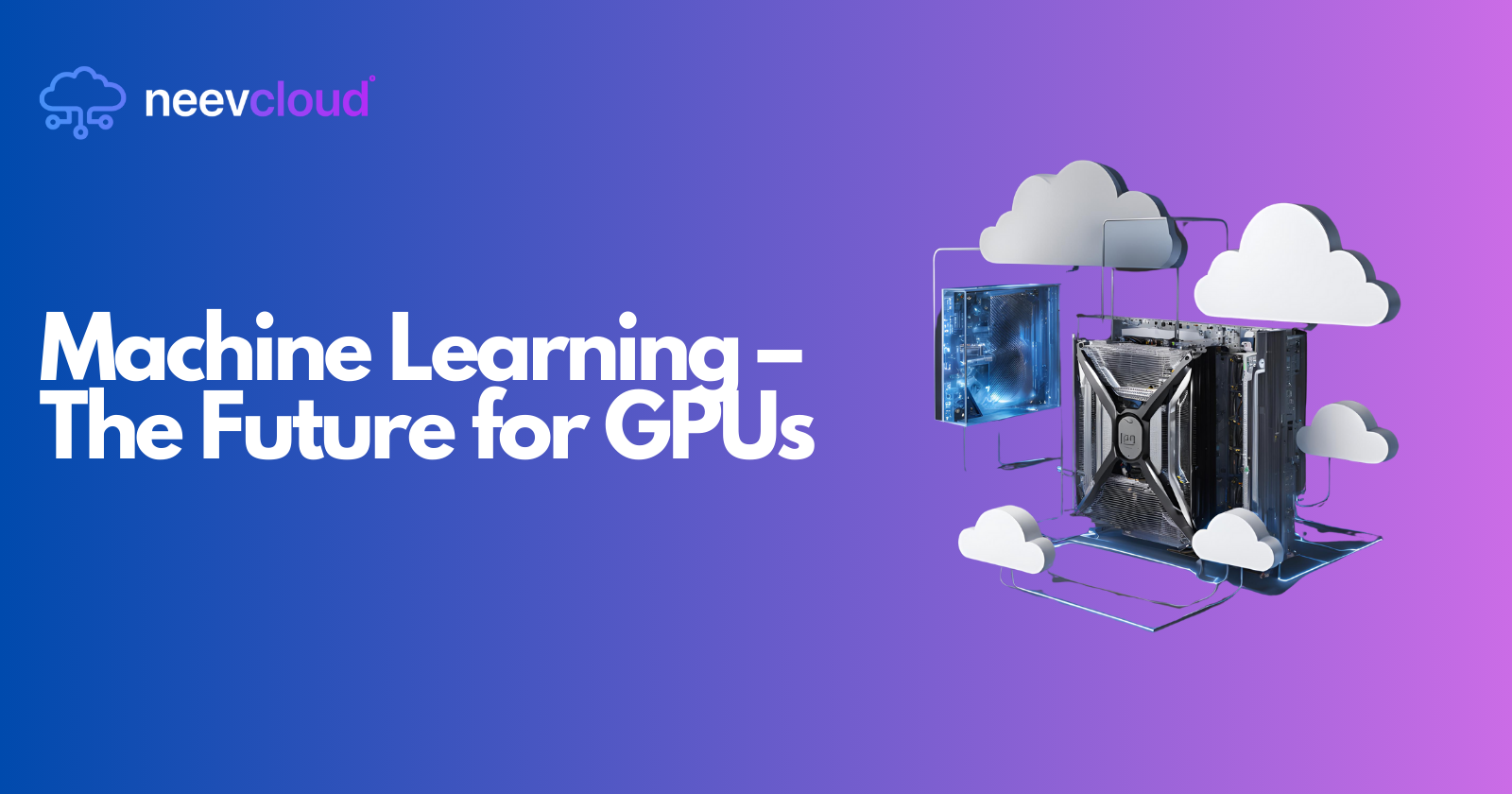Machine Learning – The Future for GPUs
 Tanvi Ausare
Tanvi Ausare
Machine Learning (ML) has proven to be a transformative technology across various industries. Its potential for powering new, intelligent applications is undeniable. The GPUs behind ML algorithms have emerged as the technology's backbone, evolving alongside it to address increasing computational demands. As the world migrates to AI Cloud and AI Datacenter solutions, the role of GPUs becomes even more critical.
In this blog, we explore why GPUs are pivotal for cloud machine learning workloads and how they are shaping the future of AI and ML applications.
Introduction: The Growing Need for Cloud-Based GPUs
The surge in data and complexity of AI ML models requires unprecedented computational power.
Traditional CPUs cannot keep up with the demand, pushing developers to adopt Cloud GPU solutions.
In the AI Cloud, Cloud GPUs enable scalable, high-performance computing necessary for ML model training and inference.
Understanding the Power of GPUs for Machine Learning
Parallel Processing: Unlike CPUs, GPUs can handle thousands of operations simultaneously, making them ideal for ML algorithms.
Data Throughput: With large memory bandwidth, GPUs handle extensive datasets effectively, a critical factor for deep learning models.
Efficient Training and Inference: GPUs provide faster training and inference, reducing model development time and improving application responsiveness.
Optimization for ML Frameworks: Many ML frameworks, like TensorFlow and PyTorch, are optimized for GPUs, resulting in improved performance and usability.
Cloud-Based GPU Evolution and the AI Datacenter
The AI Datacenter is purpose-built to house extensive GPU infrastructure for supporting enterprise-scale AI workloads.
Cloud GPU resources offered by providers such as NVIDIA, AWS, and Google Cloud enable easy access to powerful GPUs without the need for hardware procurement.
High-Density GPU Servers: In AI Datacenters, these servers aggregate GPU resources, maximizing efficiency for ML processes and reducing latency.
Data Sovereignty and Security: The AI Cloud also ensures secure data processing and storage, vital for businesses working with sensitive information.
The Advantages of GPUs in Cloud Machine Learning
1. Scalability
With cloud machine learning, companies can easily scale GPU resources based on model complexity and workload needs.
Scalable GPU resources allow on-demand access to more processing power, reducing project costs and timelines.
2. Cost-Effectiveness
Cloud-based GPUs provide an easy pay model, ensuring businesses only pay for resources they use.
This model significantly reduces upfront costs, making Cloud GPU adoption feasible for startups and large enterprises alike.
3. Reduced Training Times
GPUs in the AI Cloud allow ML models to be trained much faster than on traditional CPU-based setups.
Faster training cycles lead to quicker product iterations, giving businesses a competitive edge.
4. Enhanced Model Performance
GPUs improve the inference capabilities of ML models, enabling real-time predictions and decisions.
In applications such as fraud detection or autonomous driving, these real-time capabilities are invaluable.
5. Energy Efficiency
AI Datacenters powered by GPUs are designed for energy-efficient performance, minimizing environmental impact.
GPUs’ energy-efficient architecture contributes to a more sustainable ML ecosystem.
AI ML Workloads Ideal for Cloud GPU Solutions
Deep Learning and Neural Networks
Ideal for handling tasks with large datasets, such as image recognition, speech analysis, and NLP.
GPUs accelerate complex layers in neural networks, crucial for training sophisticated AI models.
Reinforcement Learning
GPU-powered reinforcement learning applications are expanding into robotics, autonomous systems, and gaming.
GPUs provide fast processing for continuous feedback loops, accelerating learning and model adaptability.
Generative AI and Large Language Models (LLMs)
These models require extensive computational power due to their vast number of parameters.
Cloud GPUs make it possible to train and deploy large language models efficiently.
Data Processing and Analysis
GPUs expedite tasks like data preprocessing, transformation, and augmentation.
Faster data processing enhances the model’s accuracy and reduces the time to insights, essential for data-driven decision-making.
Key Trends and Innovations in Cloud GPU for Machine Learning
1. Multi-GPU and GPU Clusters
Multi-GPU setups are becoming standard for intensive ML training tasks, enabling higher throughput and model accuracy.
Clusters allow parallel processing across multiple GPUs, boosting model processing speeds and improving efficiency.
2. GPUs and Edge AI
As edge computing gains traction, GPUs are being integrated into edge devices to deliver ML capabilities closer to data sources.
Cloud-connected edge devices equipped with GPUs enable real-time ML processing, ideal for IoT applications.
3. AI Optimization and Hyperparameter Tuning
GPUs accelerate hyperparameter tuning and optimization, allowing for a more efficient ML model lifecycle.
Optimization techniques tailored for GPU processing enable higher accuracy while maintaining efficiency.
4. Advances in GPU-Accelerated Machine Learning Frameworks
Frameworks like RAPIDS and cuML from NVIDIA bring GPU-acceleration directly to data science workflows.
These frameworks simplify complex ML tasks, reducing barriers for data scientists leveraging GPU power.
Benefits of Cloud GPU Integration for Business Applications
Lower Operational Costs: Cloud-based GPUs reduce the need for in-house hardware, decreasing operational expenses.
Enhanced Agility and Flexibility: Businesses can adjust GPU resources as their ML demands fluctuate.
Improved Data Insights: Faster processing with GPUs helps organizations achieve data insights sooner, driving informed decision-making.
Increased Competitiveness: With accelerated development cycles, companies can innovate more quickly and respond to market changes effectively.
Future of Machine Learning with Cloud GPU and AI Datacenters
1. Democratization of Machine Learning
AI Cloud and Cloud GPU solutions provide smaller organizations access to high-performance resources traditionally reserved for large corporations.
This democratization of technology allows more businesses to incorporate AI and ML into their operations.
2. Specialized GPU Architectures for AI ML
The evolution of GPUs continues with innovations like NVIDIA’s A100 and H100, designed explicitly for AI and ML workloads.
These GPUs feature optimizations for deep learning, making them ideal for handling the next generation of ML algorithms.
3. Growing Demand for AI Datacenter Infrastructure
As AI adoption accelerates, AI Datacenters equipped with GPU infrastructure will play a critical role in meeting the computational demands.
AI Datacenters are optimized for massive data processing, positioning them as the core of future ML advancements.
4. Integrated AI and ML Services
Cloud providers are offering integrated AI and ML services, where businesses can access pre-trained models and tools for streamlined ML deployment.
These services simplify the process of adding AI to applications, increasing the ease of adoption across industries.
Conclusion: Why GPUs are Essential for the Future of Machine Learning
GPUs have become indispensable in the world of cloud machine learning, enabling complex AI applications and advancing AI ML capabilities. With their unparalleled processing power, GPUs are poised to drive the future of ML, especially within the AI Cloud and AI Datacenter ecosystems. As AI continues to shape the technological landscape, GPU-powered solutions will play a pivotal role in unlocking ML's full potential across industries.
This comprehensive look at the future of GPUs for machine learning highlights their crucial role in advancing AI-driven technologies.
Subscribe to my newsletter
Read articles from Tanvi Ausare directly inside your inbox. Subscribe to the newsletter, and don't miss out.
Written by
